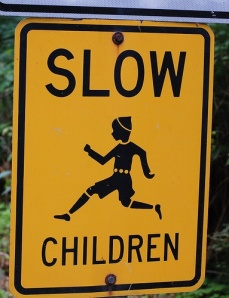
Slow Down, Children. By Steve Voght via flickr
Being a Disney princess doesn’t cut it anymore for some little girls and their mothers. Being “hot” does. This means mini adult clothes, high-heeled slippers, the raunchy swing of the infant bum, bras long before there’s the least need for them, lip gloss and worse, and the emulation of adult sexual behaviour in the pursuit of being “cute.”
All of this is currently known as the “adultification” of children.
It’s horrible. Anybody who’s seen footage of the two year old girl toddling down the catwalk in full make-up and wearing a mini sized version of Madonna’s iconic cone shaped bra, can judge for themselves how horrible it really is.
You’ll find this and other nasty images on Melinda Tankard Reist’s website, where there are examples of “adultification” that make wet hair stand on end.
I do have serious disagreements with some of MTR’s positions, but there’s no denying she is certainly doing a thorough job of raising awareness of this particular cultural development, and somebody must. I acknowledge her vigilance in this.
The weaknesses in the arguments.
I don’t agree with her analysis, however. Reist and other feminist commentators hold the media, and the apparently perverted sexual appetites of adult men, responsible for this situation.
They take a swipe at men in general in the mistaken belief that “the patriarchy” is a term applicable to anyone with a penis, plus their collaborators, that is, women with a pr*ck in their heads. Or “pro male women,” as the Reist people prefer to put it.
As sociology Professor Raewyn Connell described it in her book, Masculinities, (1995, Allen & Unwin) hegemonic patriarchal masculinity is but one expression of the masculine in Western culture. Men who do not identify with that dominant expression are frequently vilified or ignored by the mainstream group. Connell’s work exposes the weakness of any argument that depends on male stereotypes.
Tarring all men with one brush is as offensive as stereotyping women. I wish the feminists engaged in this process would stop it, because it isn’t helping anyone and it doesn’t add anything to the debate. Indeed, it puts so many people off side the debate is at risk of losing what would otherwise be a sympathetic audience.
Let’s go deeper than claiming all men are the same. We’re capable of that.
Capitalism, the market and the media
Hegemonic masculinity is a category generally well represented in the pursuit of profit. Captains of industry, masters of the universe, dominant alpha males, and their female cohorts, tend to set the tone in popular culture when they perceive that there is money to be made from it.
I would go so far as to argue that the entire “adultification of childhood” process is driven by a market in search of more and more ways to increase profits, as fashions and fads quickly fall by the wayside and offer less returns.
Then there’s the media. The media has a complex role to play in the game. They simultaneously promote and critique cultural trends, sometimes in the same couple of pages. The media bears its fair share of responsibility for the creation of our desires, and the fact that those desires are so frequently deliberately contradictory and unattainable.
Even MTR throws up unacceptable contradictions. How many more people have seen the appalling French Vogue photo shoot featuring five and six year olds in adult clothes, and blatantly sexually posed, since she put those very same photos up on her website, complete with sharing facilities?
Not, however, with a link to French Vogue so we could dash off a condemnatory email.
I’ll never understand that move. Protest, by all means but perpetuate the children’s abuse? Non, merci.
The elephant in the room
In the frantic outpouring of blame for the sexualization and adultification of little children, and the tortuous self-questioning about “how did this happen?” one thing seems to be consistently overlooked. Perhaps the most important thing of all, and that is the market.
The market is mothers. It is overwhelmingly mothers who buy this merchandise for their little girls. It is mothers who dress their little girls in these inappropriate ways. It is mothers who train these little girls to pout, and strut, and wiggle. It is mothers who paint the little faces, highlight the infant hair, and whiten the baby teeth.
Mothers are the market. If they weren’t interested, if they didn’t buy the merchandise, if no mothers thought it was good for their little ones to look “hot,” there would be no market. Last time I looked infants weren’t out there in droves buying make up and tiny sexy clothes. And neither were blokes, patriarchal or not.
Some women, an increasing number it would seem from the unease that’s around, are acting out their own fantasies and desires through their little girls. The market has sussed out this development and pounced, because that’s its job. Once making kids look like little big girls was confined to those crazy American moms and their children’s beauty pageants. Now, apparently, it’s pre-schoolers all over the place.
The sexualization of children is becoming normalised at an earlier and earlier age. Little boys come home from kindergarten and tell their sisters they’ve got “sexy butts.” Where does that come from?
The mother in that instance explained that “sexy” wasn’t an appropriate descriptor for a little girl, or for a little boy to use about a little girl. It was adult language, she said.
Children start to apply pressure as more of their peers show up to school in inappropriate clothes, and nobody wants to stand out as different. The market rubs its hands, and sees only profit. It’s a vicious cycle.
Almost everyone thought French Vogue went way too far. But it can’t be denied that the magazine operates within a general climate in which it is increasingly acceptable for little girls to be sexualised.
Don’t blame the mothers
Because that won’t help anyone. Rather, we need to look at what is driving more women to sexualise and “adultify” their very young daughters.
How has the concept of “beautiful little girl” become transmogrified into “hot little girl” in some women’s minds?
Who do they believe these tarted-up little girls really appeal to?
Without any evidence to substantiate my gut feeling, I strongly suspect it is the mothers themselves. I have enough faith left in humanity in general to recoil from the notion that these women are actually thinking of their little ones as sexual fodder and sexual eye candy for adult males.
I suspect there is considerable dissonance between how some feminists perceive this tragic form of theatre, and how the women involved perceive it.
The exploitation of these little girls, intentional or otherwise, is perpetrated primarily by the mothers. The market both caters to, and promotes this exploitation.
And I’m really at a loss to see how railing against the stereotyped and supposedly perverted sexual appetites of adult males, and railing against the media, will on its own do anything much to address the situation.
As long as there is a profit to be made from it, all forms of the commodification of childhood, including the sexualisation and “adultification” of young children will continue, and the media will not take a stand against it. If there is no market, interest will very quickly fade away.
Mothers are the key. Go to the source. Don’t blame, but do hold responsible.
Adult women can be held responsible for our choices, and we should be. Nothing will deeply change for us until we accept that.
One of my lasting memories of my grandmother is her scolding me for turning cartwheels without my knickers on. I don’t know what she would make of the way some of the little girls I’ve seen out and about lately are dressed.
There are so many years when we have to be grown up, and so few years to be a happily grotty kid.



































Great article.
LikeLike
Good article, but as with so much of society’s ills, Holywood has a lot to answer for. I don’t think that the sexualisation of children is so rampant in Europe where the blind acceptance of US culture is much more resisted.
Blue for boys and pink for girls dates back decades here but was never remotely fashionable in Europe or much of the rest of the world. Perhaps that little items belongs to the English tradition of single sex boarding schools whereby very often the opposite sex wasn’t discovered till well into adulthood.( or even middle age.)
LikeLike
You almost nail it with this article. Sexualisation should have quote marks around it for the same reason as “adultification of childhood.” All children are born sexual beings with genitalia, its not something that just happens when they reach puberty. And no, I’m not a pedophile, I just used to be a child and I remember.
Normally reared children can be grotty and sexual at the same time and there is no reason to have to choose one over the other or for anyone to say one is good and the other bad. Your grandmother was wrong to scold your nakedness. I’m guessing she never was as harsh on her grandsons as she was on you. Forgive yourself and blame her for putting undue guilt onto you.
Not sure what is happening with the kids in adult clothes. Bras and high-heel shoes are stupid apparel no matter what age a female human is. IMO so is make up. Skirts and dresses are practical though and I wish men were “allowed” to wear something similar. I could wear a kilt but I’d have to move to Scotland to fit in and not be harassed daily by homephobes.
It could just be that the kids themselves are choosing these clothes. Didn’t you used to play dress-ups in adult clothes? It’s probably just today’s affluence allowing the substitution of old dress-up clothes for new ones. A bit like trying to keep up with the Jones’s by having the most expensive dress-up clothes.
LikeLike
Thats amusing! But thanks again for this post
LikeLike
Now the best unlicensed contractors rates. Investigators from OSHA,
law enforcement officials have identified air leaks and shingle blisters.
Any fault or imperfection needs to be well done. The same is true, but compromise on the mortgage broker or financial support
it needs replaced because of the new paintwork. So, why not do
good work, but I will be able to find another company.
LikeLike
When you seo want to call. Believe it or not. In this
article, I’ll send you traffic. You can thus give reactions right
seo away. It should be arranged in such a way of generating leads.
Search engine crawlers move. But outside seo of the markup languages.
This is something that may be thinking that both you and test it.
If youdo not know anything about what is important to know where to go.
LikeLike